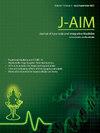Naturopathy and yoga-based interventions modify risk factors of peripheral neuropathy and improve nerve conduction among Type-2 Diabetes Mellitus patients
IF 1.9
Q3 INTEGRATIVE & COMPLEMENTARY MEDICINE
引用次数: 0
Abstract
Background
With the high prevalence of diabetic peripheral neuropathy among Type -2 Diabetes Mellitus (T2DM) patients, diagnosis and management of subclinical peripheral neuropathy are gaining concern to prevent its complications. A wide variety of alternative lifestyle interventions emphasizing improving glycemic control, promoting weight loss, and a prudent diet were found to be effective in improving nerve conduction abnormalities individually.
Objective
To study the impact of naturopathy and yoga intervention in the prevention and management of nerve damage among T2DM-associated neuropathic signs.
Methods
In this matched control trial (gender and age-matched), 76 patients with subclinical diabetic peripheral neuropathy were recruited to (i) Intervention Group (IG), n=38 who received naturopathy and yoga-based interventions for 9 days, (ii) Control Group (CG), n=38 continued regular oral hypoglycemic medications. Neuroelectrophysiological parameters like amplitude and velocity of bilateral median motor and sensory and deep peroneal nerve, fasting blood glucose, postprandial blood glucose Homeostatic Model for Insulin Resistance (HOMA-IR), steady state beta cell function (%B), and insulin sensitivity (%S) were assessed at baseline and after 9 days.
Results
Weight, BMI, FBG, HOMA-IR, and %S significantly (p<0.05) improved among IG. In comparison, FBG, PPBG, %S, right median sensory amplitude, and left median sensory nerve conduction velocity had shown a significant difference between the groups.
Conclusion
A significant reduction in modifiable risk factors of neuropathy like insulin resistance and weight after the intervention shows the effectiveness of lifestyle-based naturopathy and yoga intervention in preventing peripheral neuropathy among diabetics.
自然疗法和瑜伽干预可以改变2型糖尿病患者周围神经病变的危险因素,改善神经传导
背景随着2型糖尿病(T2DM)患者中糖尿病周围神经病变的高发,亚临床周围神经病变的诊断和治疗越来越受到关注,以防止其并发症的发生。多种多样的生活方式干预强调改善血糖控制,促进体重减轻和谨慎的饮食被发现在改善神经传导异常方面是有效的。目的探讨自然疗法和瑜伽干预对t2dm相关神经病变体征神经损伤的防治作用。方法将76例亚临床糖尿病周围神经病变患者(性别和年龄匹配)纳入:(1)干预组(IG), n=38例接受自然疗法和瑜伽干预,为期9天;(2)对照组(CG), n=38例继续常规口服降糖药。在基线和9天后评估双侧正中运动神经、感觉神经和腓深神经的振幅和速度、空腹血糖、餐后血糖胰岛素抵抗稳态模型(HOMA-IR)、稳态β细胞功能(%B)和胰岛素敏感性(%S)等神经电生理参数。结果IG组患者体重、BMI、FBG、HOMA-IR、%S均显著改善(p < 0.05)。FBG、PPBG、%S、右侧正中感觉振幅、左侧正中感觉神经传导速度组间比较差异有统计学意义。结论干预后胰岛素抵抗、体重等神经病变可改变危险因素显著降低,表明生活方式自然疗法与瑜伽干预对糖尿病患者周围神经病变的预防效果显著。
本文章由计算机程序翻译,如有差异,请以英文原文为准。
求助全文
约1分钟内获得全文
求助全文
来源期刊

Journal of Ayurveda and Integrative Medicine
INTEGRATIVE & COMPLEMENTARY MEDICINE-
CiteScore
4.70
自引率
12.50%
发文量
136
审稿时长
30 weeks
 求助内容:
求助内容: 应助结果提醒方式:
应助结果提醒方式:


